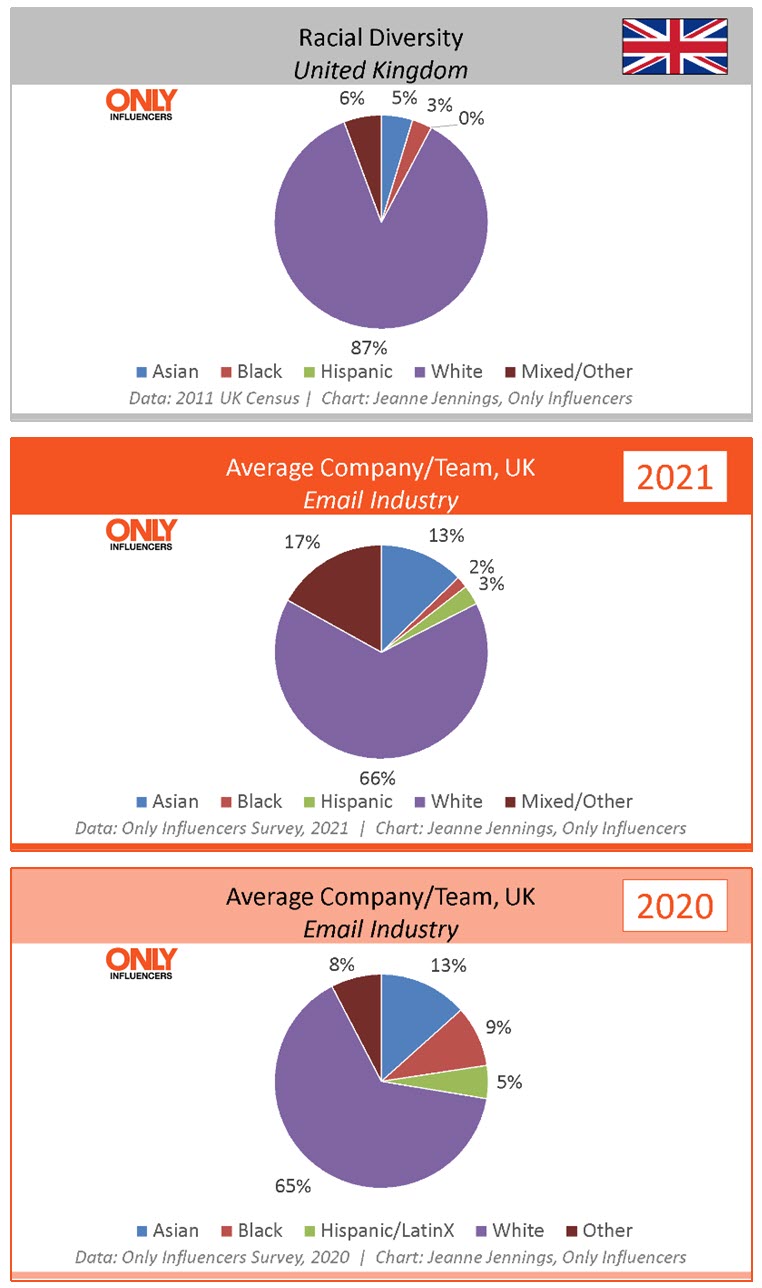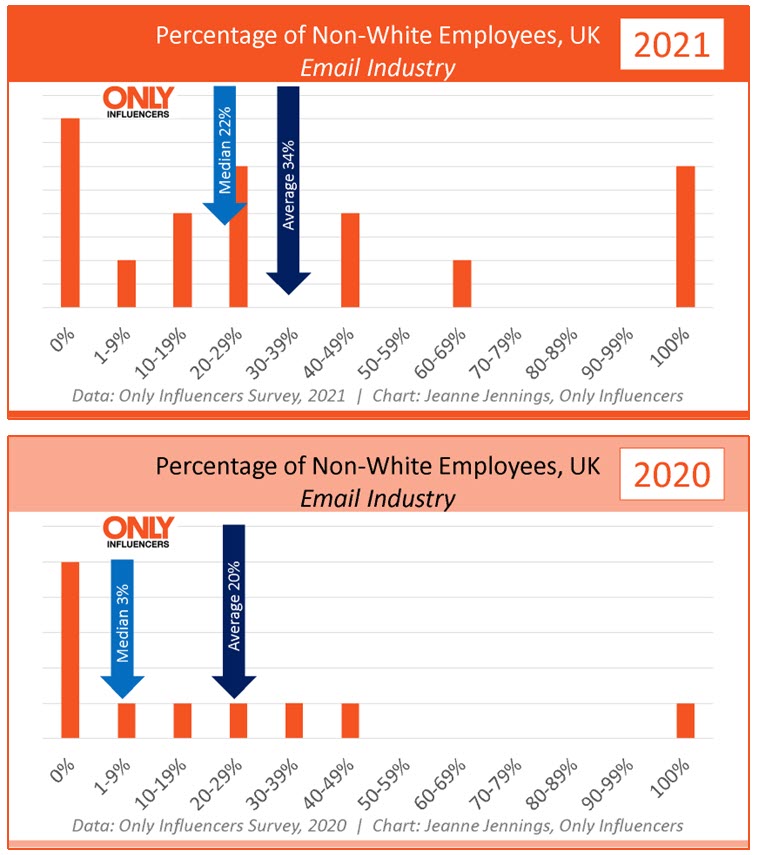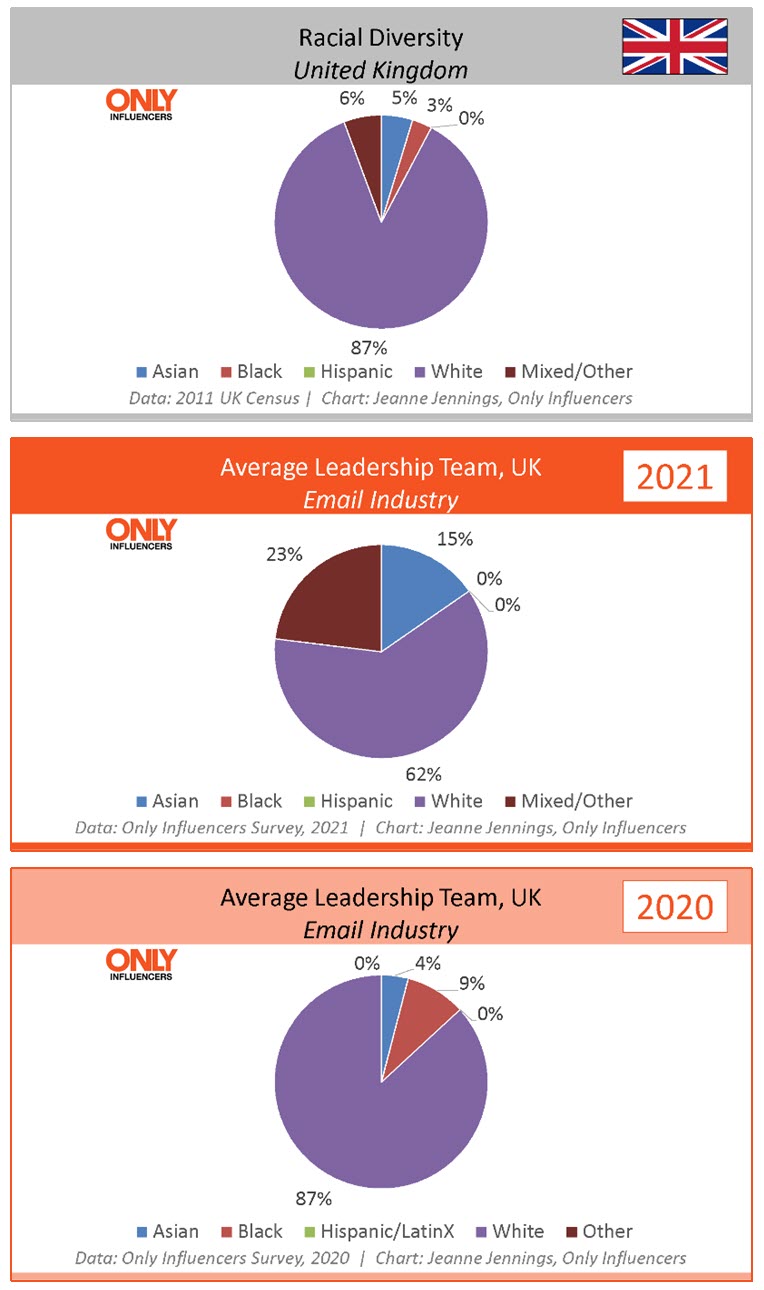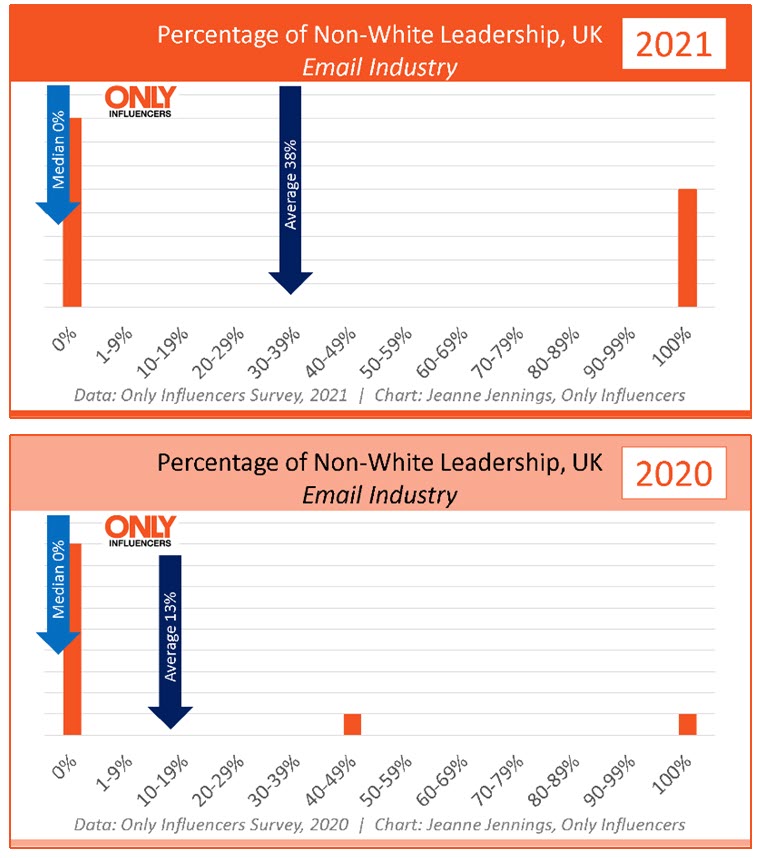Racial Diversity in the UK Email Industry
Our goal is to have the diversity in the United Kingdom (UK) email industry match that of the UK census by January 2025. Won't you help us by taking the 2022 Racial Diversity in the Email Industry Survey? It's now open through October 31, 2022 (we extended it), covering the US, UK, and the world. Takes just 5 minutes; come with the racial mix of your company or team and its leadership.
So how did the UK email industry fare in the 2021 survey? The results are mixed.
 Our 2021 survey found that the UK email industry bests the census with regard to employing people of color (34% in the industry, compared to just 14% of the population at large).
Our 2021 survey found that the UK email industry bests the census with regard to employing people of color (34% in the industry, compared to just 14% of the population at large).
The percentage of Asians in the industry is nearly triple that of the population (13% compared to 5%). Those of Hispanic descent account for 3% of the average email company but don’t register in the census. Those of mixed/other racial backgrounds are 17% of the industry, but just 6% of the population.
But Black people are just 2% of most industry companies, even though they are 3% of the population.
Our 2020 survey also showed the industry faring well compared to the population as whole. So overall the UK email industry is faring well compared to the census.
Please note that the companies responding to the survey this year are not all the same companies that responded last year, so it’s not a true apples-to-apples comparison. Also, the UK conducts the census every 10 years, so we will have new census data to compare the industry to next year, in our 2023 report.

We also compared the average and median percentage of people-of-color in the average UK email organization.
In the 2021 survey, the median was 21% and the average was 34%. Last year the median was just 3%, while the average was 20%.
You can see how different the distribution of organizations is this year. We still have a large number of companies with ‘0%’ people of color in their organizations. But in the most recent survey there are many more organizations with 10-19%, 20-29%, and 100% people of color in their ranks. The average and median numbers are moving close together, toward alignment, which is a good sign.
When the median and average are not aligned, it means that some companies are very diverse while others aren’t diverse at all. This was the situation last year. See the bar chart at the bottom right? The tall bar at the left over ‘0%’ represents the number of companies with no people of color.
In a truly diverse industry, the median and averages would be the same or at least close. This was an area we identified last year as needing work and there is good news on this front in the latest survey results.
While there is still work to be done here, we feel good about the shift we’ve seen toward more diversity in just a year’s time in the UK.
 We also wanted to see if there was progress on diversity in leadership.
We also wanted to see if there was progress on diversity in leadership.
Looking at our 2021 survey results you can see that the UK email industry leadership bested the UK census here, just as it did in the average company figures.
Those of Asian descent make up 15% of leadership roles in the UK email industry, but only 5% of the UK population. Those of mixed/other backgrounds were also more prevalent in the upper levels of the UK email industry (23%) than in the UK census (6%).
Black people are under-represented in the UK email leadership, with no presence there in most organizations, even though they make up 3% of the UK population.
The 2021 survey results are very different from the results of the 2020 survey.
We saw the percentage of Asians in high-level email roles increase, from 4% in 2020 to 15% in 2021. Also moving up – those of mixed/other backgrounds; they made up 0% of leadership in 2020, compared to 23% in 2021.
But all is not rosy. The percentage of Black people in leadership at UK email companies fell from 9% in 2020 to 0% in 2021.
The 2021 survey results were a bit of a surprise, compared to last year. As we mentioned earlier, it’s not the same group of companies responding so it’s not an apples-to-apples comparison. But still…
So, this is a goal for future – to make sure that not only are people of color represented in leadership, but that people of all racial backgrounds are there. We’ll be watching this closely.
 Finally, we looked at the median and average percentages of non-white leadership in UK email companies.
Finally, we looked at the median and average percentages of non-white leadership in UK email companies.
While the average measures the overall number, the median identifies the number in the middle where there are just as many companies with a higher percentage of non-white people in leadership as there are companies with a lower percentage.
In the 2021 survey, we had a median of 0% and an average of 38%. Looking at the chart you’ll see the polarization, with roughly 60% of companies having no non-white people in leadership positions, and 40% having 100% of leadership roles held by non-whites.
This result is a little better than the 2020 survey, but there is still work to be done.
In the 2020 survey we had a median of 0% and an average of 13%. So, while we’ve seen more companies increase diversity at the leadership level since last year, it’s still not enough to make a dramatic impact.
A polarized industry is not a diverse industry. We hope to see inroads here as we continue to provide resources and information to help companies become more diverse.
Editor's Note: This was originally published as part of the 2022 Benchmark Report: Racial Diversity in the Email Industry, by Only Influencers, based on data from the 2021 Email Industry Diversity Survey.
The 2022 Racial Diversity in the Email Industry Survey is now open, through October 31st, 2022 (it's been extended). Won't you take 5 minutes to tell us about the racial mix of your company or team and its leadership? We're reporting on the US, the UK, and the World -- but we need your help! Thanks in advance.
 Photo by Womanizer Toys on Unsplash
Photo by Womanizer Toys on Unsplash

 How to resolve AdBlock issue?
How to resolve AdBlock issue? 
